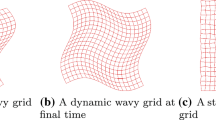Abstract
We introduce an efficient split finite element (FE) discretization of a y-independent (slice) model of the rotating shallow water equations. The study of this slice model provides insight towards developing schemes for the full 2D case. Using the split Hamiltonian FE framework (Bauer et al., A structure-preserving split finite element discretization of the rotating shallow water equations in split Hamiltonian form (2019). https://hal.inria.fr/hal-02020379), we result in structure-preserving discretizations that are split into topological prognostic and metric-dependent closure equations. This splitting also accounts for the schemes’ properties: the Poisson bracket is responsible for conserving energy (Hamiltonian) as well as mass, potential vorticity and enstrophy (Casimirs), independently from the realizations of the metric closure equations. The latter, in turn, determine accuracy, stability, convergence and discrete dispersion properties. We exploit this splitting to introduce structure-preserving approximations of the mass matrices in the metric equations avoiding to solve linear systems. We obtain a fully structure-preserving scheme with increased efficiency by a factor of two.
Access this chapter
Tax calculation will be finalised at checkout
Purchases are for personal use only
Similar content being viewed by others
References
Bauer, W. [2016], A new hierarchically-structured n-dimensional covariant form of rotating equations of geophysical fluid dynamics, GEM - Intern. J. Geomathematics, 7(1), 31–101.
Bauer, W., Cotter, C. J. [2018], Energy-enstrophy conserving compatible finite element schemes for the shallow water equations on rotating domains with boundaries, J. Comput. Physics, 373, 171–187.
Bauer, W., Behrens, J. [2018], A structure-preserving split finite element discretization of the split wave equations, Appl. Math. Comput., 325, 375–400.
Bauer, W., Behrens, J., Cotter, C.J. [2019], A structure-preserving split finite element discretization of the rotating shallow water equations in split Hamiltonian form, preprint: https://hal.inria.fr/hal-02020379
Bauer, W., Gay-Balmaz, F. [2019]: Towards a variational discretization of compressible fluids: the rotating shallow water equations, J. Comput. Dyn., 6(1), 1–37.
Bauer, W., Gay-Balmaz, F. [2019], Variational integrators for anelastic and pseudo-incompressible flows, J. Geom. Mech., 11(4), 511–537.
Beirão Da Veiga, L., Lopez, L., Vacca, G. [2017], Mimetic finite difference methods for Hamiltonian wave equations in 2D, Comput. Math. Appl., 74(5), 1123–1141.
Bochev, P., Hyman, J. [2006], Principles of mimetic discretizations of differential operators, Compatible Spatial Discretizations, IMA Volumes in Math. and its Applications, 142, 89–119.
Cotter, C. J., Thuburn, J. [2012], A finite element exterior calculus framework for the rotating shallow-water equations, J. Comput. Phys., 257, 1506–1526.
Dubinkina, S., Frank, J. [2007], Statistical mechanics of Arakawa’s discretizations, J. Comput. Phys., 227, 1286–1305.
McRae, A. T., Cotter, C. J. [2014], Energy- and enstrophy-conserving schemes for the shallow-water equations, based on mimetic finite elements, Q. J. R. Meteorol. Soc., 140, 2223–2234.
Natale, A, Cotter, C. J. [2017], Scale-selective dissipation in energy-conserving FE schemes for two-dimensional turbulence, Q. J. R. Meteorol. Soc., 143, 1734–1745.
Palha, A., Rebelo, P. P., Hiemstra, R., Kreeft, J. and Gerritsma, M. [2014], Physics-compatible discretization techniques on single and dual grids, with application to the Poisson equation of volume forms, J. Comput. Phys., 257, 1394–1422.
Pavlov, D., Mullen, P., Tong, Y., Kanso, E., Marsden, J.E., Desbrun, M. [2010] Structure-preserving discretization of incompressible fluids, Physica D, 240, 443–458.
Staniforth, A., Thuburn, J. [2012], Horizontal grids for global weather and climate prediction models: A review, Q. J. R. Meteorol. Soc., 138, 1–26.
Author information
Authors and Affiliations
Corresponding author
Editor information
Editors and Affiliations
Rights and permissions
Copyright information
© 2021 Springer Nature Switzerland AG
About this paper
Cite this paper
Bauer, W., Behrens, J., Cotter, C.J. (2021). A Structure-Preserving Approximation of the Discrete Split Rotating Shallow Water Equations. In: Vermolen, F.J., Vuik, C. (eds) Numerical Mathematics and Advanced Applications ENUMATH 2019. Lecture Notes in Computational Science and Engineering, vol 139. Springer, Cham. https://doi.org/10.1007/978-3-030-55874-1_9
Download citation
DOI: https://doi.org/10.1007/978-3-030-55874-1_9
Published:
Publisher Name: Springer, Cham
Print ISBN: 978-3-030-55873-4
Online ISBN: 978-3-030-55874-1
eBook Packages: Mathematics and StatisticsMathematics and Statistics (R0)




